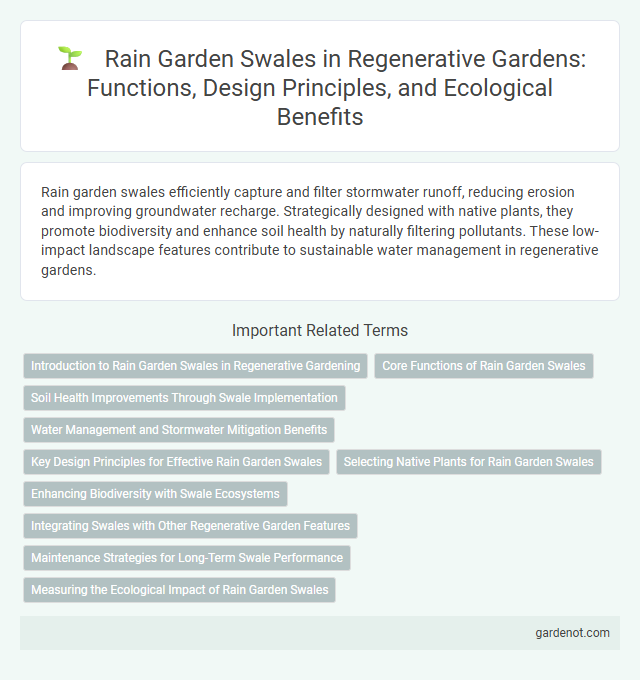Rain garden swales efficiently capture and filter stormwater runoff, reducing erosion and improving groundwater recharge. Strategically designed with native plants, they promote biodiversity and enhance soil health by naturally filtering pollutants. These low-impact landscape features contribute to sustainable water management in regenerative gardens.
Introduction to Rain Garden Swales in Regenerative Gardening
Rain garden swales are shallow, vegetated channels designed to capture and infiltrate stormwater runoff, reducing erosion and promoting groundwater recharge in regenerative gardening. These swales support diverse native plant species, enhance soil health, and improve local water quality by filtering pollutants. Integrating rain garden swales maximizes water efficiency and fosters resilient, sustainable landscapes.
Core Functions of Rain Garden Swales
Rain garden swales play a critical role in managing stormwater by capturing and filtering runoff, reducing erosion, and replenishing groundwater supplies. These vegetated channels slow down water flow, promote sedimentation, and facilitate natural infiltration processes essential for maintaining soil health and supporting native plant growth. Effective rain garden swales enhance biodiversity and improve water quality by removing pollutants before they enter local waterways.
Soil Health Improvements Through Swale Implementation
Rain garden swales significantly improve soil health by enhancing water infiltration and reducing surface runoff. Their design promotes microbial activity and nutrient cycling, leading to increased organic matter and soil fertility. By capturing and filtering rainwater, swales prevent erosion and support sustainable soil regeneration in regenerative gardens.
Water Management and Stormwater Mitigation Benefits
Rain garden swales enhance water management by capturing and directing stormwater runoff into vegetated areas, promoting infiltration and reducing surface water flow. These swales mitigate stormwater impacts by filtering pollutants, minimizing erosion, and decreasing the volume and velocity of runoff entering local waterways. Implementing rain garden swales supports groundwater recharge and improves urban water quality while reducing the burden on stormwater infrastructure.
Key Design Principles for Effective Rain Garden Swales
Rain garden swales optimize stormwater management by incorporating key design principles such as appropriate sizing based on runoff volume, graded slopes for controlled water flow, and native plant selection for enhanced infiltration and pollutant filtration. Permeable soil media and overflow outlets prevent flooding while promoting groundwater recharge. Implementing these elements ensures effective water capture, reduces erosion, and supports local biodiversity in regenerative gardens.
Selecting Native Plants for Rain Garden Swales
Selecting native plants for rain garden swales enhances water absorption and supports local biodiversity. Plants such as sedges, rushes, and wildflowers with deep root systems improve soil infiltration and prevent erosion. Native species adapt to regional climate conditions, reducing maintenance needs while promoting habitat for pollinators and wildlife in regenerative gardens.
Enhancing Biodiversity with Swale Ecosystems
Rain garden swales significantly enhance biodiversity by creating microhabitats that support diverse plant and animal species, including native wildflowers, amphibians, and pollinators. These swale ecosystems improve water infiltration and nutrient cycling, promoting soil health and sustaining beneficial microorganisms. Integrating rain garden swales into regenerative landscapes fosters resilient ecosystems that boost local wildlife populations and ecological balance.
Integrating Swales with Other Regenerative Garden Features
Rain garden swales strategically integrate with bioswales and rainwater harvesting systems to enhance water infiltration and reduce runoff in regenerative gardens. These swales complement native plantings and mulching practices, promoting soil health and biodiversity while managing stormwater sustainably. Combining swales with permeable pathways and rainwater storage creates a holistic, resilient ecosystem that supports plant growth and mitigates erosion.
Maintenance Strategies for Long-Term Swale Performance
Regular inspection and removal of debris ensure optimal water flow and prevent clogging in rain garden swales. Incorporating native vegetation with deep root systems enhances soil stability and promotes natural filtration of pollutants over time. Periodic sediment removal and regrading maintain swale capacity, supporting long-term stormwater management and ecosystem health.
Measuring the Ecological Impact of Rain Garden Swales
Rain garden swales improve water quality by filtering stormwater runoff, reducing pollutants such as nitrogen and phosphorus that contribute to eutrophication. Quantitative assessment involves monitoring parameters like infiltration rates, pollutant concentrations, and biodiversity indices to measure ecological benefits. Long-term data collection on vegetation health, soil moisture, and microfauna diversity provides insight into the swale's role in supporting local ecosystems and mitigating flood risks.
Rain garden swale Infographic

 gardenot.com
gardenot.com